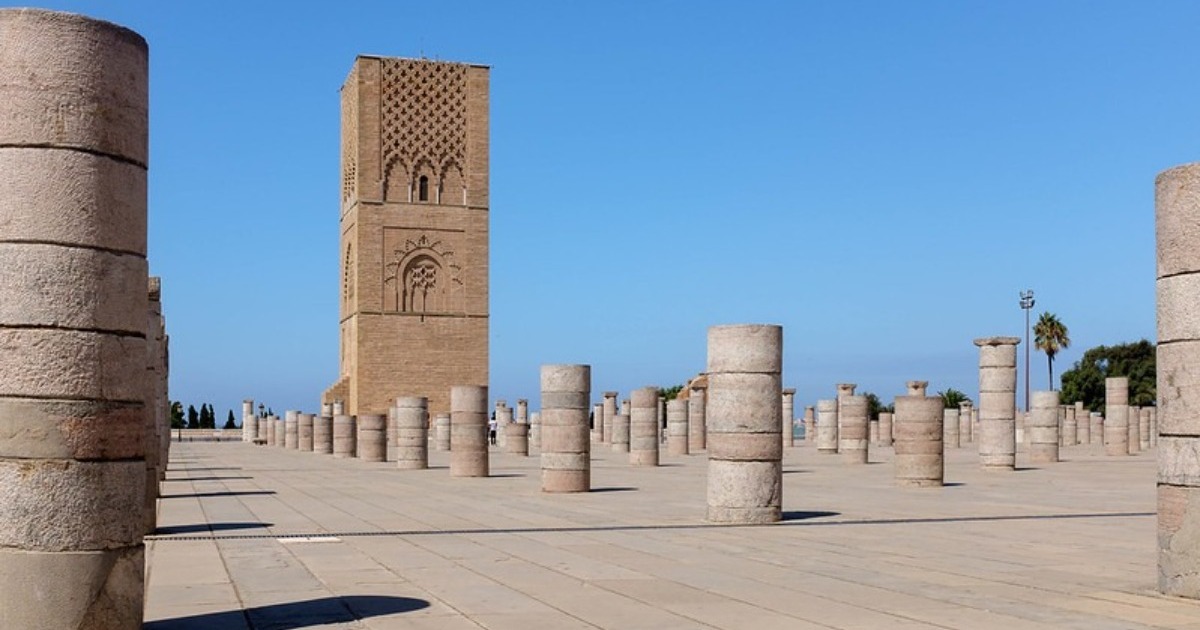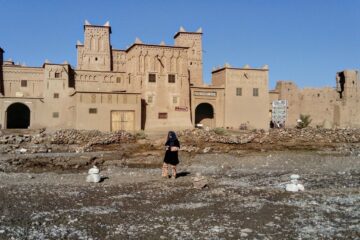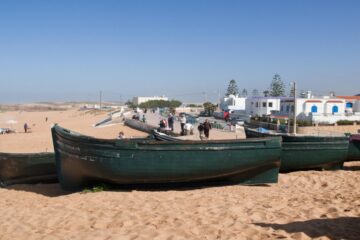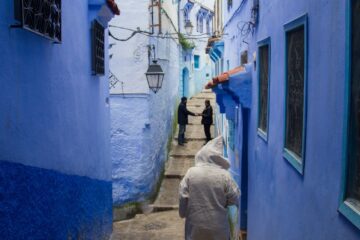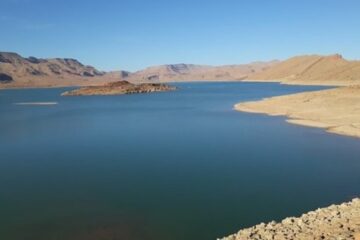The Hassan Tower in Rabat is an unfinished minaret of a magnificent mosque from the twelfth century.
About the Hassan Tower mosque
If you are planning a journey to Morocco, be sure to include a stop in Rabat, the country’s capital. Rabat contains a number of significant monuments that are worth investigating. Hassan Tower is one of the city’s most recognizable landmarks.
The Hassan Tower is a landmark that has endured for centuries. It was constructed in the 12th century by the reigning Almohad dynasty as part of an unfinished mosque.
The structure stands 44 meters tall and is adorned with intricate carvings and embellishments. Considered one of the richest instances of the Almohad style, the structure is a genuine Islamic architectural masterpiece.
For anyone interested in history or architecture, a trip to the Hassan Tower is a must. You can take a guided tour to learn more about the tower’s intriguing history and construction.
The tower is situated in a park with breathtaking vistas of the neighboring area.
Getting to the Hassan Tower is simple, and renting a car is a wonderful option for those who want to explore Rabat at their own leisure.
There are numerous car rental agencies in the city, the majority of which offer reasonable rates. You may also hire a taxi or utilize public transportation to reach the tower.
History of the Hassan Tower mosque
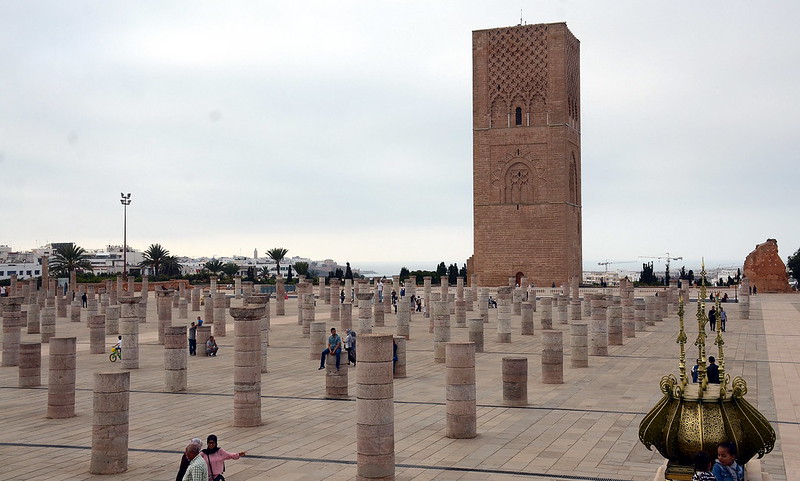
Hassan Tower is a red stone minaret built during the reign of Yacoub El Mansour, an Almohad sultan who ruled from 1184 A.D.
The Hassan Tower was intended to be the tallest mosque in the world when construction began around 1195 AD. The architecture was influenced by Islamic and Moorish styles from Al-Andalus, Spain, to Marrakech, Morocco, and Alexandria, Egypt. However, the capital of the Almohad Caliphate remained in Marrakech and not in Rabat.
However, only four years had elapsed before the sultan passed away, taking the business with him. In 1755, an earthquake obliterated the mosque’s construction (348 columns and the walls’ foundations).
In the 20th century, French and Moroccan archaeologists excavated and rebuilt the entire site. In the 1960s, the remnants of the mosque were relocated to make way for Mohammed V’s mausoleum.
Today, several columns surround the Hassan Tower, demonstrating the intended layout of the mosque. Not even the Hassan Tower had been completed. Despite its current height of 44 meters, it was originally intended to be twice as large. There are six levels inside the Hassan Tower, each of which has a solitary chamber and staircases that enable the muezzin to mount a horse and ride to the tower’s top for the call to prayer.
Also read the Best Things To Do In Rabat.
The Building of Hassan Tower
The Hassan Tower, located on the northeastern side of Rabat, was intended to be constructed in a location where there was insufficient population to support a mosque.
Historians believe that the building was intended to function as both a mosque and a fortress, or as part of a magnificent capital city.
The Ikhshidi mosque of Ahmed Ibn Taulune in Egypt served as the model for the Hassan Tower, which has a distinctive structure that consists of staircases rather than stairs.
Thus, the mue’zzin were able to access the structure on horseback in order to make their supplication calls.
The tower’s central core consists of six levels, each with vaulted chambers and windows with horseshoe-arched openings that offer breathtaking views of the surrounding area.
The exterior of the tower is adorned with sebka panels and joint columns carved from stone and inlaid with marble, as decorative elements are given a high priority in Islamic architecture.
Following the Almohad architectural style, approximately 200 cylindrical stone columns and masonry piers were used to construct the mosque’s structure.
The primary element of the mosque, the open courtyards, was intended to consist of three parallel structures flanking the mihrab, pointing toward Mecca. Unfortunately, the mosque was never completed, and the sections that were finished sustained devastation during the Lisbon earthquake in 1755.
The Hassan Tower is a masterpiece of Islamic architecture, and its distinctive characteristics and rich history make it a must-see for tourists in Rabat.
A Contemporary Masterwork
The magnificent Mausoleum of Mohammed V is situated adjacent to the unfinished remains of the Hassan Tower.
Built in the 1950s and unveiled in 1961, six years after Mohammed V’s death, the structure is now regarded as an outstanding example of contemporary Alouite dynasty architecture.
The exterior of the building has white walls and a typical green-tiled roof, but the interior is intricately decorated with the finest examples of traditional Moroccan craftsmanship.
The magnificent zellij mosaics that ascend from the marble floors to the ceiling of hand-carved cedar wood and gold leaf are a testament to the Moroccan people’s exquisite artistry.
The monuments of monarch Mohammed V (grandfather of the current monarch of Morocco) and his two boys, which are located on the ground level, are one of the mausoleum’s most prominent features.
The white onyx-carved monuments are guarded by royal guardians and security personnel wearing traditional fez caps, and can be observed from an interior balcony that surrounds them.
This breathtaking site is open to all visitors every day, and non-Muslims are invited to enter both the sacred mausoleum and the adjacent small mosque.
The royal soldiers, mounted on horses and attired in elaborate uniforms, stand at the main entrance and are typically willing to pose for photos.
Visitors are advised to dress modestly and to avoid the mausoleum between noon and 2 p.m., when it is closed for midday prayers in the mosque.
The Hassan Tour mosque today
The complex, along with the adjacent mausoleum, remains Rabat’s must-see attraction and is a UNESCO World Heritage site. Be on the lookout for the beautiful decorative sekba panels, and be sure to visit the photogenic pillar remnants. The ideal time to visit the complex is at dawn or dusk, when the light has a particularly beautiful hue.
Getting there
The structure is located in Quartier Hassan, behind the Mausoleum of Mohammed V; you should be able to meander through the grounds to it readily. It is approximately 2 kilometers from Rabat’s Medina, which is walkable but requires crossing some congested roadways. Taxis are abundant in the medina, so call one if the heat or confusion overwhelms you.
Conclusion
The Hassan Tower in Rabat is an architectural marvel that attracts visitors and history buffs from around the globe.
This towering minaret is not only a symbol of Rabat but also a symbol of the city’s abundant cultural heritage. Due to its intricate design and historical significance, it is a must-see for anyone traveling to Morocco.
If you are planning a journey to Morocco, you should include the Hassan Tower in Rabat. It’s an extraordinary experience that you don’t want to miss.
The breathtaking vistas, enthralling history, and impressive architecture will astound you.

